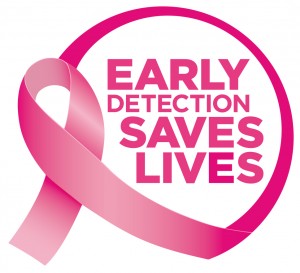Women in the United States have a 1 in 8 chance of getting breast cancer. The good news is that
when breast cancer is detected early, it can be cured. Studies show that the five-year survival rate for localized breast cancer is 97 percent, while the 12-year survival rate is 95 percent for cancers that are detected while still smaller than 1 centimeter in size. The size of the cancer and how much it has spread are two of the most important factors contributing to the success of treatment.
The key to successful treatment is early detection and screening. Screening exams are designed to find breast cancer while it is still small and localized – before it causes symptoms like an obvious lump. Breast cancers detected after symptoms arise are usually bigger and are more likely to have spread to areas beyond the breast. Early detection saves thousands of lives each year, so it’s important for women of all ages to know what tests are available and when to get them.

logo credit: Breast Cancer Action
Women Ages 50+
Women in their 50s are at the greatest risk of contracting breast cancer. What are some ways to prevent it? Watch your weight! Women who gain weight (20 pounds or more ) after menopause are significantly more likely to be diagnosed with breast cancer than women who maintain a healthy weight.
Maintain at least a yearly mammogram to monitor any possible breast cancer developments.
Women Ages 40 – 49
Women 40 and older should have a mammogram each year, as long as they are healthy and free from serious health problems like congestive heart failure, end-stage renal disease, dementia, etc.
Various types of mammograms are available today, including 2D film or digital mammograms and 3D mammograms. Regardless of type, a mammogram is safe and is considered to be the best available test for detecting and diagnosing breast cancer.
Film, digital and 3D mammograms all use compression and a series of X-rays to generate pictures of internal breast tissue. During the exam, the technician compresses the breast with a paddle and takes images from various angles to obtain the necessary pictures.
If a patient receives abnormal mammogram results, doctors often order a breast ultrasound or an MRI breast scan as a follow-up test. These tests can zero in on a specific area identified by the mammogram, and they can help shed more light on whether the area in question might be a cyst or solid mass. A breast ultrasound or MRI breast scan can also sometimes distinguish between benign and cancerous tumors and can help doctors determine whether steps such as a stereotactic breast biopsy are necessary.
Women in 20s and 30s
Younger women – those in their 20s and 30s – should have clinical breast exams every three years. A CBE is usually done in conjunction with a mammogram and is an opportunity for women to discuss any changes in breast tissue, options for medical imaging scans, and any hereditary factors that could increase breast cancer risk.
A breast self-exam is another option for women starting in their 20s, and is something that can be done on a monthly basis throughout life. While self-exams play a smaller part in detecting breast cancer compared to other methods, they nonetheless help women become familiar with how their breasts normally look and feel. This makes it more likely that a woman will notice if a change occurs – perhaps a lump, swelling, pain, discharge, etc. Many times these symptoms are not cancerous, but they should always be reported to a doctor so the appropriate follow up tests can be done.
For a woman in her 20s, the odds of contracting breast cancer are quite low; however, the risk does increase with age. CBEs and self-exams enable women to know what is normal for them so they can immediately report any changes to their doctors.
High-Risk Women
Today, doctors use various risk assessment tools – such as the Gail model, the Claus model, and the Tyrer-Cuzick model – to help determine a woman’s risk for breast cancer. These tools give approximations of risk based on various factors and data. Genetic testing is also available and can identify whether a woman carries the BRCA1 or BRCA2 gene mutation.
For women who are identified as high-risk patients, experts recommend a yearly mammogram and MRI breast scan. An MRI breast scan is used in addition to a mammogram, rather than in place of it. While an MRI is more sensitive than a mammogram, it does miss some cancers that a mammogram can otherwise detect.
In most of these high-risk cases, the combination of mammograms and MRI breast scans should start at age 30 and continue as long as a woman is healthy enough to receive the tests. However, the age to start the exams should take personal situations and needs into account and can be modified accordingly by the doctor and patient.
Women having any of the medical imaging scans mentioned above should do so at a certified diagnostic imaging center to ensure they receive the most accurate tests possible. The Center for Diagnostic Imaging is proud to offer Comprehensive Breast Care Centers in the Miami area that offer all women access to life-saving mammograms, breast ultrasounds and MRI breast scans.








